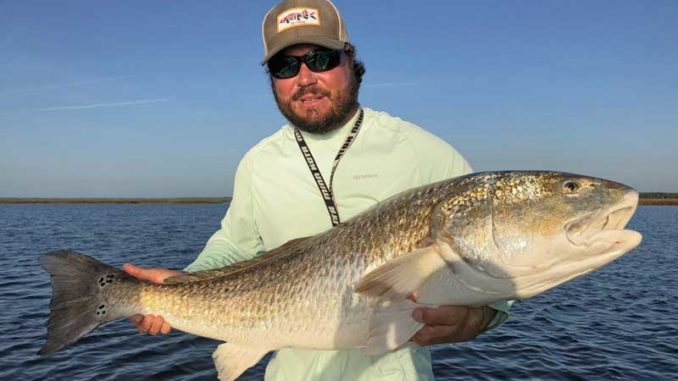
Big, old drum make first appearance of season in July.
July marks the unofficial start of fishing season for “old” red drum in North Carolina’s major sounds, coastal rivers and tributaries. The bite usually lasts through October, with August and September the peak months.
Redfish of all ages and sizes swim in these waters, particularly the Pamlico and Albemarle sounds and coastal rivers, principally the Neuse.
Richard Andrews of Tar-Pam Guide Service (252-945-9715) has chased these drum for many seasons. But the main fishing tactic has changed since the popping cork-artificial lure approach arrived on the scene about 10 years ago.
Instead of anchoring on ledges and using heavy tackle to soak chunks of cut-bait for hours, the technique now resembles one used for speckled trout, smaller redfish, flounder and striped bass.
“My rig includes a concave-mouth Bomber Paradise Popper cork and a 6-inch Z-Man (swimbait) on a 1/4-ounce jighead. Or I’ll use a topwater lure,” said Andrews, of Bath, N.C. He fishes ledges in the northern section of the lower Neuse River, plus the Pungo and Bay rivers.
Never underestimate the importance of fishing with the right gear
His rig includes 30-pound braid spooled on a 4000 or 5000 series spinning reel mated to a 7-foot, medium-heavy TFO rod. He ties the braid to a 2 ½-foot section of 60-pound monofilament, then 2 ½ feet of 60-pound mono leader to the popping cork’s bottom swivel with a swimbait on the business end.
“The 60-pound (leader) is helpful when you’ve hooked a 50-pounder,” Andrews said. “With a surge, a fish can break off at the boat. I also use a large landing net.”
When he pops his rod tip, the cork’s splash attracts drum, which hopefully see a lure that resembles a wounded menhaden. But if fish are feeding on the surface, Andrews may throw a 6- to 7-inch plug that anglers often cast for tuna or amberjack.
“(Old drum) don’t really favor a specific color, as long as it includes some white,” he said.
Look for menhaden
But Andrews’ key visual clue is menhaden schools at the surface or below.
“Sometimes (baitfish) don’t show (on top), but you can look for them with a fish-finder,” he said. “If you see bait schools below, often (old drum) will bite if you throw near them. Usually, baitfish associate with ledges, so if you don’t see surface baits, you need to stay with it.”
Andrews said a typical trip may feature six to 10 fish hooked and landed. But he said, “I have caught as many as 30. Any time you catch more than five old drum, that’s a good day.”
North Carolina regulations allow fishermen to keep only one drum per day in an 18- to 27-inch slot. Bigger and smaller fish must be released immediately.
“If you hook and land a big drum, get him to the boat as quickly as possible,” Andrews said. “Net him and pull him onboard. Take a quick photo while supporting his belly with one hand and head with the other. But never pick up a drum or hold one vertically by the gills. Then, release him as quickly as you can.”
Click here for a great knot to use when chasing old drum.


